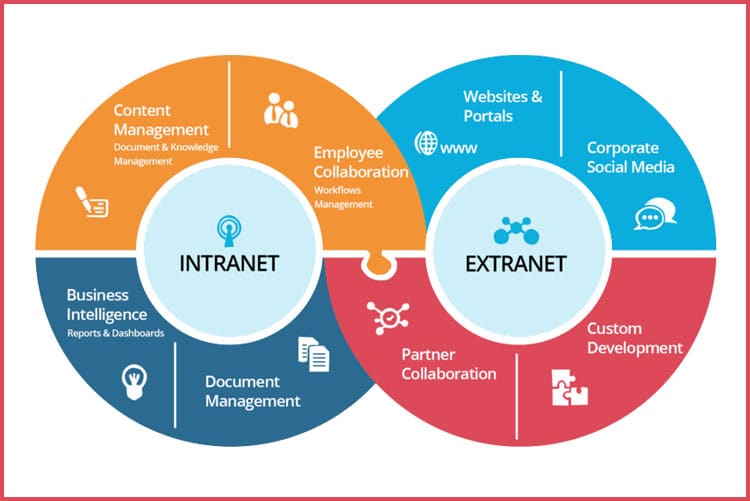With the growing dependence on the internet, most businesses use both intranet and extranet for work and communication purposes.
One can hear the terms intranet and extranet almost daily while working and communicating with team members, customers, business associates, etc. it is easy to get confused with the terms intranet and extranet.
They both are similar as their chief purpose is to improve and increase communication and collaboration. Though their role or purpose is the same on the whole intranet and extranet are very different.
Intranet vs. Extranet: What is the Difference?
Before learning about the difference between intranet and extranet, let us first understand the application of intranet and extranet, their examples, and their uses.
What is Intranet?
The Intranet is a private network used by a company to enable secure communication and collaboration amongst its employees; it is also useful for storing internal information.
The prefix infra means within or inside, so in simple words, an intranet is the company’s digital workspace which is centralized. It helps in streamlining every individual, document, tools, projects, etc. within the company.
What is an extranet?
Similar to the intranet, the extranet is also a private network within an organization; however, it uses the internet to connect to outsiders in a controlled manner.
Extranet helps in connecting organizations with their customers and suppliers, which helps in working collaboratively.
In simple words, it is the organization’s intranet that is extended to authorized users outside the organization. A controlled, private network that enables third-party partners to access certain information without granting complete access to the organization’s entire network.
Similar to the intranet, extranet allows private communication, file, and information sharing, However, in this case, it is between authorized external partners and the organization.
Intranet vs. Extranet: what do they do?
Intranets usually begin with publishing web pages informing about the upcoming company events, company health, safety or security policies, staff newsletters, etc.
Intranet gives access to forms for claiming expenses or for requesting leaves and holidays. Having all this online on the organization’s internal network helps in eliminating unwanted paperwork and speed up the process.
Additional features that are essential for the operation of the organization can be added to the intranet. It can be made into a portal that provides easy access to all the things required by the employees.
Firewalls are used for protecting the intranet from the global internet, employees can log in to the intranet only with the help of a secure password.
Employees or contractors working for the organization but are located at different locations can access the intranet by using a VPN (a virtual private network). All the communications made between the intranet and the individual’s personal computer is encrypted.
Extranet provides access to a business network to people working for different organizations. For example, a business can provide access to its supplier to make online ordering, order tracking, and inventory management simpler.
Instead of sending information to the suppliers on each occasion, the extranet allows the suppliers to automatically access the required information. Another example of the extranet is the hospital appointment booking system.
Under the booking system, the doctors can access the hospital’s system to make appointments for their patients. Since the communications made of the extranet can be encrypted over a VPN, it is more secure as compared to sending data over the public internet.
Intranet vs. Extranet: The key differences
- Purpose:
Intranet – The main purpose of the Intranet is to enable the sharing of sensitive and confidential information within the organization.
Extranet – Extranet allows communication of information between the employees of the organization and the external business associates.
- Regulation:
Intranet – It is regulated by the specific organization and its organizational policies.
Extranet – It is regulated by 2 or more organizations which are sharing the information and data. It is regulated by the contractual agreements made between the organizations.
- Accessibility:
Intranet – The content is accessible only by the members or employees of the organization.
Extranet – The content is accessible by the employees of the organization and external members who have been given access to the network.
- Security:
Intranet – The network is secured by a firewall.
Extranet – The network is secured through a firewall that separates the internet and extranet.
Intranet vs. Extranet: The Final Words
Intranet and Extranet both have many similarities, including their main purpose to increase communication and collaboration. Though similar they have some differences, their chief difference can be determined from the first few letters of their name.
The prefix intra means internal or inside. Which means it is an internal network dedicated to the employees of the organization.
The prefix extra means external or it refers to any contact or activity outside your business like clients, vendors, and suppliers.

